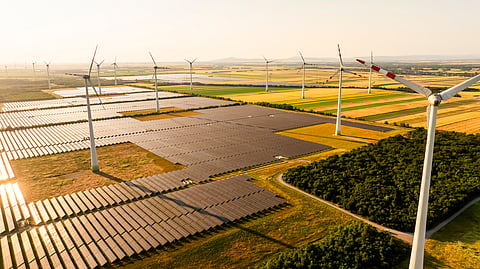

India’s power generation increased 3.6% in July–September, driven by an 18.6% surge in renewable output.
Non-fossil fuel sources accounted for 83% of record quarterly capacity additions totalling 16,071 MW.
Solar continued to dominate, helping push total installed capacity beyond 500 GW.
Transmission constraints are emerging as a key challenge, with solar curtailment up 12% in October.
India’s power generation rose close to 4 per cent in the July-September quarter this year, driven by a sharp increase in renewable electricity that offset declines in coal and nuclear output, official data shows.
Power generation in India rose 3.6 per cent year-on-year to 484.07 billion units in the third quarter of 2025 (July-September), driven by an 18.6 per cent surge in renewable electricity. Strong monsoon-fed hydropower and sustained growth in solar and wind output offset a 1.6 per cent decline in fossil fuel-based generation and an 18.6 per cent fall in nuclear power, according to figures from the Central Electricity Authority and analysis by the Institute for Energy Economics and Financial Analysis.
The trend underlines how cheaper renewable electricity is increasingly displacing costlier coal and nuclear power across the grid.
Even as generation expanded, India’s upstream transition accelerated at a record pace. The country posted its highest-ever quarterly net capacity addition of 16,071 megawatts in the third quarter of 2025, with non-fossil fuel sources accounting for nearly 83 per cent of the new installations. Solar alone contributed 11,084 MW, followed by coal (2,760 MW), wind (1,449 MW) and large hydro (730 MW).
This pushed India’s total installed power capacity past the 500 GW milestone, reaching 500.9 GW by the end of September. Of this, 256 GW or 51.1 per cent now comes from non-fossil fuel sources. Solar continued to dominate with a 69 per cent share of new additions, supported by developers rushing to commission projects ahead of higher interstate transmission system charges introduced in July 2025.
Between January and September, India added 38,887 MW of net new capacity — a 59.4 per cent increase on the same period in 2024. Solar (29,468 MW), wind (4,961 MW) and large hydro (3,140 MW) remained the key drivers, even as coal capacity also ticked up.
States saw a reshuffling in rankings. Maharashtra led renewable additions in the third quarter with 3,362 MW, fuelled by soaring open-access solar demand from industrial consumers. The growth pushed its total renewable capacity to 27,959 MW, overtaking Tamil Nadu to become India’s third-largest renewable energy state after Rajasthan and Gujarat.
But the rapid additions have put growing pressure on the electricity grid. Solar curtailment rose 12 per cent in October compared with May, highlighting transmission bottlenecks as renewable output outpaces midstream infrastructure.
Investment momentum has kept pace. Renewable energy investments more than doubled year-on-year to US$5.23bn in the third quarter of 2025, bringing the nine-month total to US$18bn — already surpassing full-year investments made in 2022, 2023 and 2024.
Major announcements from the Adani Group, Oyster Renewables, AM Green, SAEL and Jakson Group reflect strong confidence in India’s energy transition trajectory, with substantial capital flowing into renewable generation, manufacturing and storage-linked hybrid projects.
As India moves towards its 2030 target of 500 GW of non-fossil capacity, the latest data points to a system undergoing rapid restructuring — with renewable generation rising, fossil-based output plateauing and capacity expansion reaching historic levels.